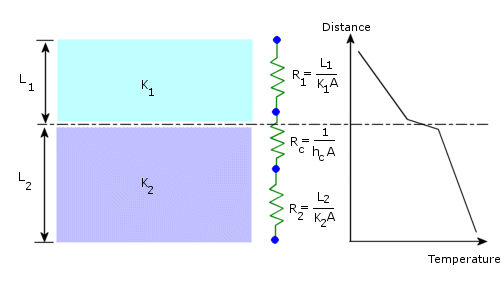The usefulness of the analogy between the flow of electric current and the flow of heat becomes apparent when a satisfactory description of the heat transfer at the interface of two conducting media is needed. Due to machining limitations, no two solid surfaces will ever form a perfect contact when they are pressed together. Tiny air gaps will always exist between the two contacting surfaces due to their roughness.

Through the interface between the two contacting faces, two modes of heat transfer exist. The first is conduction through points of solid-to-solid contact (Qconduction) which is very effective. Secondly, conduction through the gas filled gaps (Qgap) which, due to its low thermal conductivity, can be very poor. To treat the thermal contact resistance, an interfacial conductance, hc, is placed in series with the conducting media on both sides as shown in the next figure.

The conductance hc is similar to the convection heat transfer coefficient and has the same units (W/m2 ºK). If ΔT is the temperature difference across an interface of area A, then the rate of heat transfer Q is given by Q = A hc ΔT. Using the electrical-thermal analogy, you can write Q = ΔT/Rt, where Rt is the thermal contact resistance and is given by Rt = 1/(A hc).
The interfacial conductance, hc, depends on the following factors:
- The surface finish of the contacting faces.
- The material of each face.
- The pressure with which the surfaces are forced together.
- The substance in the gaps between the two contacting faces.
The following table shows some typical values of the interfacial conductance for normal surface finishes and moderate contact pressures (1 to 10 atm). Air gaps not evacuated unless so indicated:
| Thermal Resistance, RthermalX10-4 (m2.K/W)
|
|---|
| |
|---|
| Contact Pressure
|
100 kN/m2 |
10,000 kN/m2 |
|---|
| Stainless Steel
|
6-25
|
0.7-4.0
|
| Copper
|
1-10
|
0.1-0.5
|
| Magnesium
|
1.5-3.5
|
0.2-0.4
|
| Aluminum
|
1.5-5.0
|
0.2-0.4
|
The following table lists the thermal contact resistance for metallic interfaces under vacuum conditions:
| Contacting Faces
|
Conductance (hc) (W/m2 ºK)
|
|---|
| Iron/aluminum
|
45,000
|
| Copper/copper
|
10,000 - 25,000
|
| Aluminum/aluminum
|
2200 - 12000
|
| Stainless steel/stainless steel
|
2000 - 3700
|
| Stainless steel/stainless steel
(evacuated gaps)
|
200 - 1100
|
| Ceramic/ceramic
|
500 - 3000
|